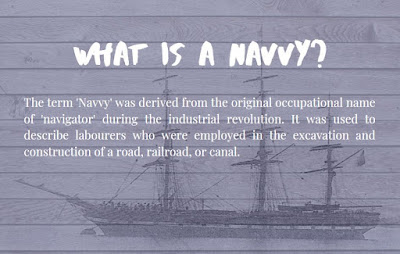Father Put Me in the Boat: The Story of the Northfleet Disaster
- Get link
- X
- Other Apps
The Northfleet and the Navvies

On the evening of January 22nd,
bad weather forced the ship to anchor in the English Channel, approximately 5
km off the coast of Dungress. The Northfleet’s crew took the appropriate
measures for anchoring at night by hanging a lighted paraffin globe from the
mast. Some thought this was an extreme precaution because the electric light of
the Dover lighthouse could be clearly seen.
The Introduction of Steamers
Over the past several years traffic in the English Channel had significantly increased because of international trade. When steamers were introduced it became mariner code that the steamers were to remain in the deeper waters of the Channel and that sailing vessels were to remain in the shallower waters near the coast. In the instance that a sailing vessel and a steamer were to be on course for a collision the saying “sail before steam” was to be upheld. Often the steamers broke these rules due to pressure from their owners to maximize trade by tracking straight and running at max speed for as long as possible.
Disaster Strikes
At approximately 10:30 pm, a steamer struck the Northfleet on the starboard side, then backed off into the darkness, leaving the Northfleet to sink with in half an hour of the collision. The steamer responsible for the collision was later identified to be the Murillo from Spain. According to the three crew members aboard the Murillo, the captain was aware that he had hit an immigrant vessel because they could clearly hear cries for help. The Murillo’s captain elected to do the unthinkable and run to the engine room ordering that the steamer regain full speed and abandon the sinking ship.
Below deck the Taplin family was fast asleep in their bunks. After hearing the sound of the Murillo crash into the starboard side, Caroline quickly ordered the children to get dressed and head to the deck. Through the chaos of people trying to fill and launch the lifeboats, Caroline managed to procure a spot for Maria. While the boat was being lowered John held Maria in his arms, all the while she cried for him to place her in the boat. After Maria was situated he picked up Carrie in his arms and began to fight through the crowded deck trying to find her a spot in another boat. This was the last Maria would ever see of her parents, and her sisters.
The death toll of the disaster was astronomical. The crew only managed to launch two of the six lifeboats - one of which lacked oars. As a result 293 of the 379 passengers perished. Of the survivors only two were women (one was the captain's wife), one was an infant (the captain's child), and one child (Maria Taplin). The rest of the survivors were men, most of which belonged to the crew. Upon investigation, the surviving crew claimed they could not launch the four cutters because "the lashings were too tight", however it was later determined that they were trying to substitute brute force for skill.
Father Put Me In The Boat: Maria Taplin's Survivor Story
Many of the other survivors gave vivid testimonies of the horrors they witnessed that night. Their accounts differ slightly but one detail always remains the same. Each of them recalls hearing Maria scream in her father's arms for him to put her in the lifeboat as it was being lowered. Their testimonies were so ponente that they inspired a song about the Maria and her family titled "Father Put Me in the Boat". I have linked the lyrics to the song here. The lyrics are truly haunting when you know the Taplin family's story.
Upon arriving in Dover the following picture was taken of her and published in papers all across the country. She was only 11 at the time. When this picture was taken the trauma she had just experienced was fresh - likely made all the more real by standing next to the sunken vessels life preserver.

Following the disaster the captain's wife escorted her to London to visit with her two married sisters. Both Emma and Mary Ann tried to convince Maria to stay with them but they were unsuccessful. Maria wanted to return to Dover and stay with a brother and sister she had met there prior to leaving for London. Donations poured in from across the country along with offers of adoption. Three years later she placed in an orphanage after it was learned that her guardians were stealing the donations she was receiving. Maria died two years later in Miss Haddon's Orphanage of consumption when she was 17. Although she survived the disaster it seems as though her spirit sank along side her parents and sisters that fateful night.
Related Articles:
Learn more about Maria's sister Mary Ann here
- Get link
- X
- Other Apps




Comments
Post a Comment